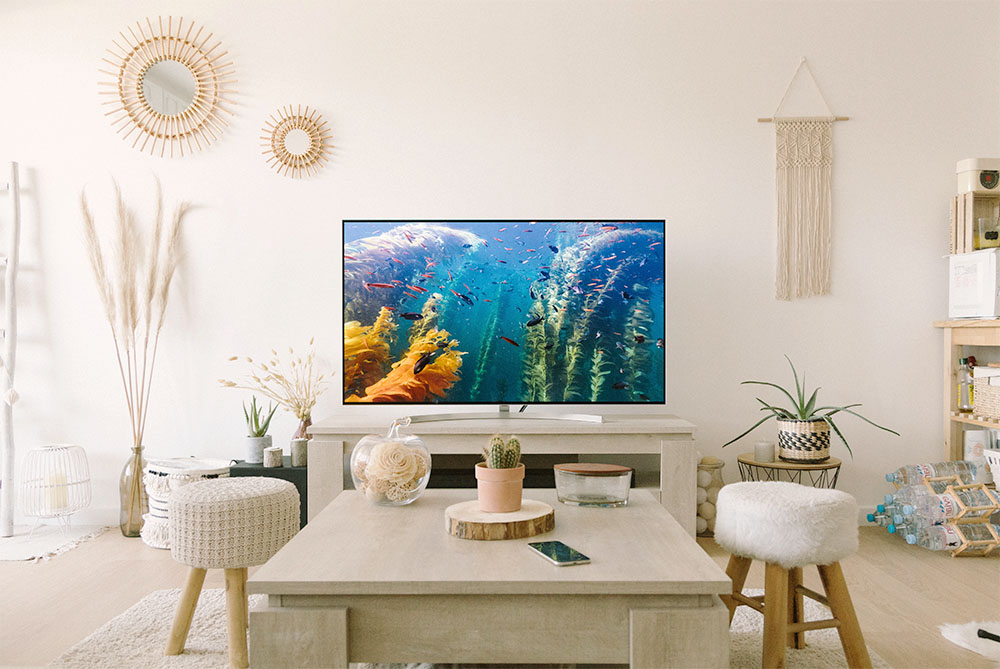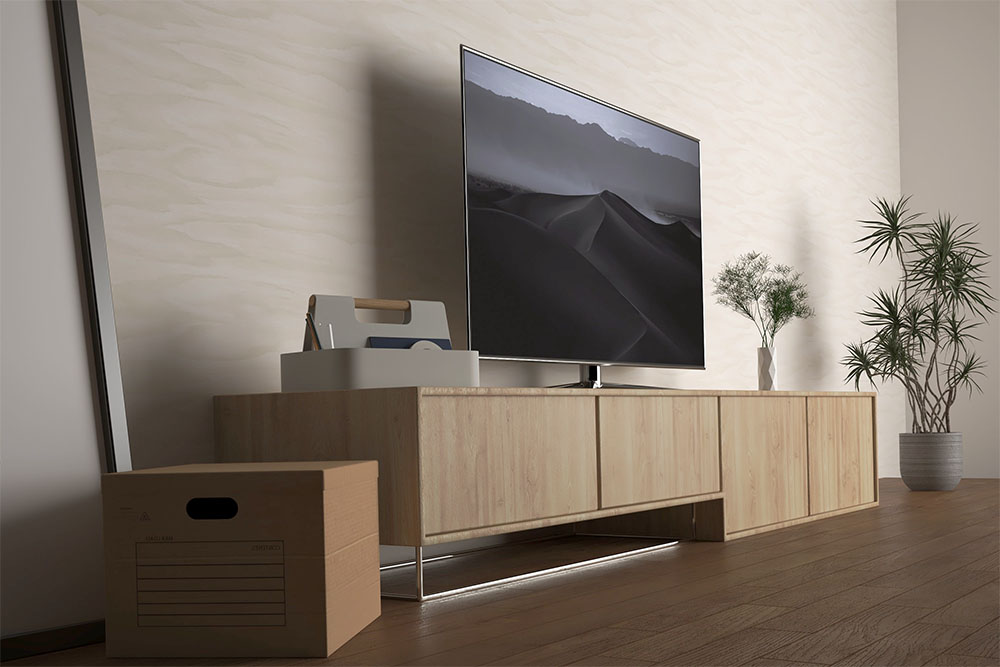
I will be honest with you. My dream home, MUST have a huge large screen TV in the living room. Followed by a more modest monitor or TV-sized monitor in my own bedroom/gaming room. That’s the top two items on my wishlist when I move into my new home.
Having the best TV buying guide in your hand is like a free ticket to purchasing the best TV in Singapore. We know it’s not always easy to step into a TV store and pick one that suits your needs. And you must consider some noteworthy points to help you choose the best TV and affordable smart TVs in Singapore. So this is what this guide aims to achieve. If that’s what you’re looking for in 2025, we hope this comprehensive TV buying guide in Singapore comes in handy as your trusty tool. Whether you’re a hardcore gamer or budget-conscious, searching for smooth visuals for family entertainment, this guide will give you the insights and knowledge to make an informed decision when choosing your latest TV models in Singapore.
What Do You Consider When Buying a TV?
When choosing a TV in Singapore, there are several essential factors to consider. Here, we’ll go through each factor to ensure that your purchase meets your needs and maximizes your viewing experience.
1. Screen Size and Room Space
If you want an ideal TV for your family, then the screen is one of the pivotal factors to remember before purchasing the best TVs for small spaces in Singapore. One of the most important factors when selecting a TV is the screen size, which should match your room’s space and viewing distance. A screen that’s too large can cause discomfort in smaller rooms, while a screen that’s too small may not provide an optimal viewing experience. A reliable TV screen size guide for Singapore homes suggests that the ideal viewing distance for HD TVs is about 1.5 times the screen’s diagonal measurement, and the ideal distance for 4K TVs is approximately equal to the screen size in inches.
For instance, if you choose a 60-inch 4K TV, sitting around 60 inches (5 feet) away will provide the clearest view without discomfort. In Singapore, where space can be limited, smaller TV models can offer a great viewing experience even in close quarters, so finding the right balance between screen size and room space is essential.
2. Resolution Choices (4K, 8K)
Resolution is a key factor in picture quality, as it directly affects the sharpness and detail of the images. Here are the main resolutions available:
- 4K (3840 x 2160 pixels): Offering four times the resolution of Full HD, 4K TVs provide a high level of clarity and crisp detail, making them the standard for most TV buyers today. With increasing content in 4K, this resolution is the best TV resolution for gaming Singapore.
- 8K (7680 x 4320 pixels): For those looking for the ultimate in picture quality, 8K TVs deliver incredibly detailed images that are ideal for large screens. However, with limited 8K content currently available, this option is best suited for tech enthusiasts or those looking to future-proof their setup.
3. TV Technology (LED, OLED, QLED)
Understanding different TV technologies can help you choose a model that’ll best matches your viewing preferences and budget. Here’s a breakdown of the main types available in Singapore:
- LED TVs: LED (Light Emitting Diode) TVs are essentially LCD screens with LED backlighting. Known for their bright displays and energy efficiency, LED TVs are a versatile, cost-effective choice that works well in rooms with varied lighting conditions. However, LED TVs can sometimes struggle with achieving true blacks due to their backlighting, which can impact contrast in darker scenes.
- OLED TVs: OLED (Organic Light Emitting Diode) TVs offer self-illuminating pixels, allowing for superior contrast, true blacks, and vibrant colors. This technology provides an immersive viewing experience, especially for gaming or cinematic viewing, as each pixel can turn on or off independently. Although OLED TVs offer top-tier picture quality, they tend to be more expensive and can be prone to burn-in with static images over extended periods.
- QLED TVs: Developed by Samsung, QLED (Quantum Dot LED) TVs use quantum dot technology to enhance brightness and color accuracy. They’re particularly suited to well-lit environments and boast durability without the risk of burn-in. However, because QLEDs still use LED backlighting, they may not reach the true black levels that OLEDs can achieve.
How Do I Figure Out What TV To Buy?
To choose the best TV for your preference, it’s important to consider some important factors. Most TVs available today come with smart features, providing access to streaming platforms, apps, and even voice control. The best budget smart TVs in Singapore still offer robust app support and streaming capabilities, making them a great choice for most households. When evaluating smart TV features to look for, consider which streaming services you use most frequently, and ensure the TV’s operating system is compatible. Popular platforms include Android TV, webOS, and Tizen, each offering unique interfaces and app availability.
1. Refresh Rate and Gaming Compatibility
TV refresh rates help you choose the right option for your needs. TV refresh rates explained to be measured in Hertz (Hz) indicate how often the image is refreshed per second. A higher refresh rate is especially important for viewing fast-moving content like sports or video games, as it reduces motion blur for smoother visuals. While 60Hz works well for regular viewing, a 120Hz refresh rate is ideal for gaming and action-heavy content, providing a more immersive experience. For gamers, other features such as low input lag and variable refresh rates are essential for a seamless experience, and many modern TVs also include gaming-specific modes to optimize picture settings for a more responsive display.”
2. Connectivity
Consider connectivity options before selecting the best TV for your needs. Most modern TVs come with multiple HDMI ports, allowing for easy connection of devices like soundbars, Blu-ray players, and gaming consoles.
Additional ports such as USB (for media playback from flash drives) and Bluetooth (for wireless connections with headphones or speakers) add flexibility to your setup. Ensure the TV has enough HDMI and other ports to support your current and future devices, particularly if you have a complex entertainment setup.
Types of TVs Available in Singapore
Understanding the various types of TVs available is essential to finding one that best suits your specific needs, room setup, and budget. Here, we break down the primary TV types you’ll encounter in Singapore:
1. LED TVs
LED TVs, which means Light Emitting Diode, are primarily LCD TVs that use LED backlighting and are popularly known and used widely because of their cost-effective and versatile technology. Similarly, they are renowned for their bright displays and energy efficiency, thus making them a popular option for lighting conditions. However, one of these TVs’ drawbacks is that they often struggle with accurate black levels, which can have a negative impact on dark scenes.
2. OLED TVs
For viewers seeking a cinematic experience or a premium display for gaming, OLED TVs (Organic Light Emitting Diode) are a top-tier option. This is the main difference between LED and OLED TVs, unlike LED TVs, OLEDs have self-illuminating pixels, which means each pixel emits its own light and can turn off independently. This feature allows OLED TVs to produce deep blacks, vibrant colors, and excellent contrast, creating a highly immersive experience.
3. QLED TVs
Samsung develops QLED (Quantum Dot LED) TVs and uses quantum dots to enhance performance. This technology plays a pivotal role in offering brighter and more color-accurate displays than traditional LEDs. The pros and cons of QLED TVs show that they excel in well-lit environments and boast a longer lifespan without the risk of burn-in. However, one downside is that QLED TVs still rely on backlighting, which means they can’t match the true blacks of OLEDs.
4K vs 8K TVs Which To Choose?
Resolution is a key aspect of TV technology that significantly affects picture quality. Here’s what to expect with 4K and 8K TVs:
- 4K TVs: With a resolution of 3840 x 2160 pixels, 4K TVs are four times as detailed as Full HD, making them the new standard for high-definition viewing. With a wide range of 4K content now available, investing in a 4K TV is a smart choice for most households in Singapore.
- 8K TVs: Offering a massive 7680 x 4320 resolution, 8K TVs provide incredibly detailed images, especially on large screens. While content in 8K remains limited, these TVs are ideal for those looking for the ultimate viewing experience or preparing for future content.
Comparison Table of TV Technologies

Look For The Best Electricians
Comparison Table of TV Technologies
Features | LED | OLED | QLED | 4K | 8K |
Technology | LED backlighting | Self-illuminating pixels | Quantum dots with LED backlight | 3840 x 2160 pixels resolution | 7680 x 4320 pixels resolution |
Picture Quality | Bright, struggles with true blacks | Superior contrast, vibrant colors | Bright and color-accurate | Crisp, clear, and detailed | Ultra-fine details |
Viewing Angle | Limited viewing angles | Wide viewing angle | Varies by model | Good, dependent on the panel | Similar to 4K, panel-dependent |
Pros | Cost-effective, energy-efficient | Excellent blacks, vibrant colors | Bright, no burn-in risk | High-resolution, affordable options | Future-proof, best for large screens |
Cons | Lower contrast, lacks true blacks | Expensive, potential for burn-in | Cant achieve OLED-level blacks | Cant achieve OLED-level blacks | Expensive, limited 8K content |
Top TV TV types and prices in Singapore
When selecting a TV, brand reputation, features, and pricing all influence the decision. Below are some of the top TV brands in Singapore, along with pros, cons, and price examples to help guide your decision.
Samsung TVs
Samsung is a well-known brand in Singapore, particularly praised for its QLED technology, which produces vibrant colors and deep blacks. Samsung TVs offer many smart features, including intuitive interfaces and compatibility with popular streaming services.
Pros
- Exceptional picture quality, vibrant colors
- User-friendly smart platform
Cons
- Higher price range; can be feature-heavy for some users
Brand Name | Product Name | Price |
Samsung | SAMSUNG Q60C 55 INCH 4K QUANTUM DOT QLED TV | $1,715 |
Samsung | SAMSUNG Q60C 85 INCH 4K QUANTUM DOT QLED TV | $5,045 |
Samsung | SAMSUNG Q60C 65 INCH 4K QUANTUM DOT QLED TV | $2,320 |
Samsung | SAMSUNG Q60C 43 INCH 4K QUANTUM DOT QLED TV | $1,109 |
Samsung | SAMSUNG CU7000 43 INCH 4K CRYSTAL UHD TV | $605 |
Samsung | SAMSUNG CU7000 65 INCH 4K CRYSTAL UHD TV | $907 |
Samsung | SAMSUNG CU7000 75 INCH 4K CRYSTAL UHD TV | $1,413 |
LG TVs
LG offers some of the best OLED TVs on the market, known for their true-to-life colors, excellent motion handling, and deep black levels. LG’s smart platform also includes AI-powered features and voice control, making LG a solid choice for those seeking a premium experience.
Pros
- Superior picture quality, especially in OLED models
- AI processing and voice controls
Cons
- Higher price tag, especially for OLED models
Brand Name | Product Name | Price |
LG | LG 43QNED75SRA.ATC 45 IN QNED75 4K SMART TV | $1,099 |
LG | LG C3 48 INCH 4K OLED EVO TV | $1,899 |
LG | LG OLED65C2PSA.ATC 65 IN LG OLED C2 EVO | $5,195 |
Sony TVs
Sony TVs are celebrated for their image processing capabilities, particularly their OLED models, which offer remarkable color accuracy, contrast, and motion handling. With Sony’s Bravia XR technology, these TVs excel in upscaling and providing high-definition images even with non-4K content.
Pros:
- Outstanding color accuracy and image processing
- Good motion handling, excellent for sports and movies
Cons:
- High price range
Brand Name | Product Name | Price |
Sony | SONY XR-65A80L 65IN BRAVIA XR 4K HDR OLED GOOGLE TV A80L SERIES | $4,299 |
Sony | SONY XR-55A80L 55IN BRAVIA XR 4K HDR OLED GOOGLE TV A80L SERIES | $3,199 |
Sony | SONY XR-77A80L 77IN BRAVIA XR 4K HDR OLED GOOGLE TV A80L SERIES | $8,999 |
Sony | SONY 32 INCH W830K 720P TV | $579 |
Sony | SONY 43 INCH X75K 4K TV | $949 |
Sony | SONY 50 INCH X75K 4K TV | $1,049 |
Sony | SONY 55 INCH X75K 4K TV | $1,199 |
Hisense TVs
Known for its competitive pricing, Hisense offers a range of options suitable for budget-conscious shoppers who still want quality performance. Hisense TVs generally provide excellent value for money and decent performance, making them popular for gaming and general home use.
Pros
- Good value for money, a wide range of sizes
- Gaming-friendly with low input lag
Cons
- Smart platform may not be as user-friendly as other brands
Brand Name | Product Name | Price |
Hisense | HS43A6K 43IN A6K 4K UHD SMART TV | $459 |
Hisense | 40 INCH HD TV 1080P HS40A4 | $399 |
Hisense | 32 INCH HD TV 720P HS32A4 | $299 |
Hisense | HS55E7K 55IN E7K 4K UHD GOOGLE TV | $899 |
Hisense | 55 INCH 4K UHD TV HS55A7G | $859 |
Hisense | HS55A6K 55IN A6K 4K UHD SMART TV | $669 |
Hisense | 65 INCH 4K UHD TV HS65A7G | $1,199 |
Philips TVs
Philips is recognized for incorporating Ambilight technology, which projects ambient light from the screen onto the surrounding walls, creating a more immersive viewing experience. This feature, combined with decent picture quality, makes Philips TVs a unique option for entertainment rooms.
Pros:
- The unique Ambilight feature enhances the viewing experience.
- Stylish designs with good picture quality
Cons:
Limited availability in some markets.
Brand Name | Product Name | Price |
Philips | PHILIPS 65PUT8528/98 65 IN 4K UHD GOOGLE LED TV WITH 3-SIDED AMBILIGHT | $1,514 |
Philips | PHILIPS 32-INCH SLIM HD LED TV 32PHT5678/98 | $299 |
Philips | PHILIPS 43 INCH FHD GOOGLE LED HD TV 43PFT6918/98 | $539 |
Philips | PHILIPS 43PUT7908/98 43 IN 4K UHD GOOGLE LED TV 3-SIDED AMBILIGHT | $679 |
Philips | PHILIPS 50PUT7908/98 50 IN 4K UHD GOOGLE LED TV 3-SIDED AMBILIGHT | $786 |
Sharp TVs
For those who prioritize affordability, Sharp offers budget-friendly options that deliver decent picture quality. Sharp TVs are generally straightforward to use and make a good choice for those looking for a basic TV option.
Pros:
- Affordable pricing
- User-friendly with straightforward functionality
Cons:
- Limited features compared to high-end brands
Brand Name | Product Name | Price |
Sharp | 50 INCH 4K ULTRA HD TV 4T-C50EJ2X | $499 |
Sharp | 42 INCH 2K FHD TV 2T-C42EG2X | $504 |
Sharp | 55 INCH 4K ULTRA HD TV 4T-C55EJ2X | $599 |
Sharp | 55 INCH 4K ULTRA HD TV 4T-C55EJ2X | $799 |
Sharp | 75 INCH 4K UHD TV 4T-C75EK2X | $2,320 |
TV Accessories and Installation Options
When setting up a new TV, the right accessories and professional installation options can enhance your viewing experience and ensure the setup complements your room’s layout. Here’s a breakdown of essential TV accessories and installation options in Singapore.
Which TV Mounting Options Singapore Is Best?
Choosing the right wall mount or stand not only ensures your TV is securely installed but also optimizes your viewing experience based on room size, seating arrangement, and aesthetic preference. Here are some TV mounting options in Singapore:
- Fixed Wall Mounts: Fixed mounts hold the TV close to the wall, making them an ideal choice for those looking for a sleek, minimalist appearance. However, these mounts don’t allow angle adjustments, so they’re best suited for rooms where you’ll view the TV straight-on.
- Tilting Wall Mounts: Tilting mounts allow you to adjust the screen’s vertical angle, which can reduce glare from windows or overhead lights. This flexibility is ideal for rooms where light conditions vary or if you need to place the TV slightly higher than your seating level.
- Full-Motion Wall Mounts: Also known as articulating mounts, these allow the greatest range of movement, enabling both horizontal and vertical adjustments. Full-motion mounts are ideal for larger rooms or open spaces where you may want to watch TV from different areas. They are also useful if you want the freedom to angle the TV for the best view while sitting, lying down, or standing.
- TV Stands: Freestanding TV stands are an excellent alternative for renters or those who prefer not to drill into walls. Stands come in various styles and heights, with some offering built-in storage space for media devices and accessories. They’re easy to move and provide flexibility if you plan on rearranging furniture in the future.
Do You Need a Soundbar or a Full Home Theater System?
The built-in speakers in most modern TVs often fall short of delivering a cinematic audio experience. For an enhanced sound experience, consider investing in a soundbar or home theater system that complements your viewing habits.
- Soundbars: Compact and easy to install, soundbars are a popular option for boosting audio without the complexity of a full surround sound setup. They are generally affordable and space-efficient, idealizing smaller rooms or minimalist setups. Many soundbars also come with subwoofers, which add depth and richness to bass sounds. Some models support surround sound features, giving you a more immersive experience for movies and music.
- Home Theater Systems: For a complete cinematic experience, a home theater system with multiple speakers provides full surround sound. These systems include multiple speakers around the room, offering a theater-like audio experience. Dolby Atmos-compatible systems add another dimension by simulating sound that moves above and around you, making it ideal for large rooms or movie enthusiasts who want an immersive audio experience.
Choosing between a soundbar and a home theater system depends on your space, budget, and viewing needs. Soundbars are great for simple audio enhancement, while home theater systems are best for users who want an in-depth, surround-sound experience.
What One Should Expect From a Professional TV Installation
Investing in professional installation services ensures your TV is securely mounted, correctly configured, and fully optimized for the best performance. Many stores and independent providers in Singapore offer professional installation, covering a range of services:
- Wall Mounting and Bracing: Professionals will precisely install wall mounts, ensuring the TV is securely attached and correctly aligned. This service is especially helpful if mounting on challenging surfaces like concrete or plaster.
- Cable Management: Effective cable management keeps wires neatly organized and hidden, maintaining a clean, clutter-free setup. Professional installers often use cable covers or in-wall solutions to conceal wires, enhancing the overall look of your entertainment area.
- Audio/Visual Setup and Calibration: Installation services can include setting up and calibrating additional audio and video components. This may involve connecting soundbars, home theater systems, gaming consoles, or streaming devices and adjusting the TV’s picture settings for optimal quality based on your room’s lighting.
- Smart TV Setup: Professionals can also assist with configuring your Smart TV settings, including connecting to Wi-Fi, downloading popular streaming apps, and setting up any integrated voice assistants so you’re ready to stream content immediately.
FAQs
Is OLED or QLED Better?
OLED and QLED are both useful in different ways. OLED offers deeper blacks than LED, and enhances contrast ratio, making it perfect for movies in dimly lit rooms. QLED is better in brightness but suitable for a well-lit environment and comes with longer durability and richer colors.
Is LG Better Than Samsung?
LG and Samsung have different strengths. LG is known for its OLED technology, delivering high contrast and deeper blacks, making it perfect for movie enthusiasts. Samsung’s QLED technology shines in brightly lit rooms and is known for its vibrant color and higher brightness, making it ideal for general use.
Is OLED Really Worth It?
For those who crave deep blacks, high-contrast, and bright, vivid colors, then OLED is worth it. Some of the benefits include a better and higher quality image when viewed in a dark environment, which makes it good when used for movies and games. However, the cost of OLED TVs in Singapore are more expensive and may not be the best choice for brightly lit rooms.
Which Brand of TV Lasts the Longest?
Sony, Samsung, and LG are known for their sturdy constructions and technologies. This can also depend on how frequently a TV is used. However, proper care such as dusting or cleaning and proper settings (like adjusting brightness to avoid burn-in) can also increase a TV’s lifespan.
Is TCL Better Than Samsung?
TCL is ranked as one of the best television manufacturing brands with relatively low prices but reasonable working efficiencies. Samsung offers higher models based on QLED technology, which provides maximum image brightness and quality.
Which Brand TV Is Best for Small Spaces in Singapore?
For small rooms, flat-screen TVs in the range of 32 to 50 inches are usually appropriate. The compact models with high refresh rates and a wide viewing angle should be preferred since they provide visibility from close seats.
What Is the Cost of OLED TVs in Singapore?
OLED TVs with screen size available in Singapore are priced between SGD 1,500 for entry-level models and more that SGD 5,000 for large high-end models.
Where Can I Buy TVs in Singapore?
If you’re looking for where to buy TVs in Singapore the best TV sets are available in most electronics stores such as Courts, Harvey Norman and Best Denki. There are also many choices in online shops such as Lazada, Shopee, and other official brands sites.
Is OLED the Best Picture Quality?
OLED TVs are generally recognized for having one of the superior picture quality, because of its self-emissive pixels. OLEDs can output true blacks and infinite contrast, increase the vividness and realism of colors, as well as images in the dark. They are suitable when watching movies in rooms with low lighting. While OLED provide the overall better picture quality, it’s better to decide in favor of your viewing environment and preferences.
FAQs about TV Buying Guide in Singapore
What are the latest trends in TV technology?
The latest trends in TV technology as of November 2025 include:
- MicroLED and MiniLED Displays
MicroLED and MiniLED technologies are gaining traction, offering brighter displays with improved contrast and energy efficiency. MicroLED, in particular, is known for producing vibrant images without burn-in issues, while MiniLED improves backlighting for deeper blacks and enhanced detail. - 8K Resolution
8K TVs continue to evolve, providing unprecedented detail with four times the resolution of 4K. As 8K content becomes more accessible, these TVs offer future-proof viewing for those seeking the highest level of clarity. - Next-Gen Gaming Features
TVs now cater to gaming with features like 4K at 120Hz, variable refresh rates (VRR), and low latency modes. HDMI 2.1 ports are increasingly common, allowing smoother, more responsive gaming experiences, especially on next-gen consoles. - QD-OLED Panels
Combining Quantum Dot technology with OLED, QD-OLED panels offer enhanced brightness and color accuracy, reducing the limitations of traditional OLED screens. This innovation brings a new level of picture quality for both movies and gaming. - Higher Refresh Rates
Refresh rates up to 165Hz are becoming available in select models, improving motion handling for sports, action movies, and gaming, ensuring smoother visuals without motion blur. - Wi-Fi 7 Integration
TVs with Wi-Fi 7 capability offer faster, more stable connections, which reduces buffering and improves streaming quality, even in environments with multiple connected devices. - AI-Powered Processing
AI-powered processors in TVs can upscale lower-resolution content to near-4K or 8K quality and personalize picture settings based on ambient lighting and content type, enhancing viewing quality without manual adjustments. - Smarter Smart TVs
Smart TVs are now smarter than ever, with integrated virtual assistants, personalized content recommendations, and compatibility with smart home ecosystems. They also support hands-free voice control and provide tailored viewing experiences. - Transparent and Foldable Displays
Transparent and foldable TV screens are emerging, offering unique installation possibilities, like embedding the TV in glass panels or folding it when not in use, making it an innovative choice for modern interiors. - Improved Energy Efficiency
TVs are being designed with eco-friendly materials and power-saving technologies, making them more sustainable and environmentally conscious without compromising performance.
What are some things to consider when mounting a TV?
- When mounting a TV, keep these key factors in mind:
- Wall Type: Ensure the wall can support the TV’s weight; use appropriate anchors for drywall or consider mounting on studs.
- Mount Height: Mount the TV at eye level when seated to reduce neck strain and enhance viewing comfort.
- Viewing Angle: Position the TV to avoid glare and ensure a clear view from your primary seating area.
- Cable Management: Plan for hidden or organized cables to keep your setup neat and avoid clutter.
- Power Outlet Location: Mount near a power source to avoid visible extension cords and ensure easy connectivity.
- Type of Mount: Choose a fixed, tilting, or full-motion mount based on your viewing needs and room layout.
How can I calibrate my TV for the best picture quality?
- To calibrate your TV for optimal picture quality, follow these steps:
- Adjust Brightness: Set the brightness so that dark scenes have depth without losing detail.
- Set Contrast: Increase contrast until bright areas are clear but not overly intense.
- Fine-Tune Color: Adjust color settings so skin tones appear natural without oversaturation.
- Modify Sharpness: Lower sharpness to avoid unnatural edges; too much sharpness can reduce clarity.
- Use a Calibration Disc or App: Many calibration tools are available to help set levels accurately.
- Enable or Disable Extra Features: Features like ‘motion smoothing’ may affect quality; experiment to see what looks best.
Final Thoughts
Choosing and buying the best TV in Singapore is not a no-brainer; there are many factors you need to deem fit before making an informed decision on the best brand for your project. So, whether you’re looking to select the best TV brand in Singapore or keep abreast of the TV prices in 2024, this TV buying guide has everything at your disposal.
All you need is to read the guide above and follow all the steps to help you locate one of the best TVs for your family or gaming. You can trust Sharp, LG, Philips, Sony, Samsung, and Hisense among the top TV brands in Singapore.
Homees.Co
Homees.co is your go-to platform to explore a wide range of reliable aircon services tailored to your needs. For service providers, joining Homees.co allows you to reach a broader audience and showcase your expertise. And be featured in our articles. Check out our other services, and join us to unlock endless possibilities for your home or business.
As Singapore’s go-to platform for home services, we make it easy for homeowners to find trusted, highly-rated vendors while providing professionals with a platform to grow their business.
Visit Homees.co today to book your next aircon servicing or to list your services and reach a broader audience!
- Check out our other services.
- Join us as a homeowner to unlock endless possibilities for your home.
- Join us as a merchant and stand a chance to be featured in our next article.
We’re here to improve your home
Speak to hundreds of reliable pros, view their gallery, inspirations, and know the best prices with our resources.
Have full control over your home improvement projects with Homees.





